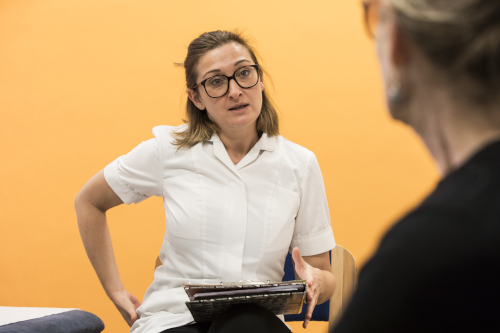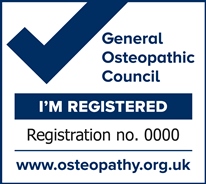What to expect
What happens when you visit an osteopath, what a treatment is likely to cost and how to find a local osteopath.
This information is also available in Welsh: Beth i’w ddisgwyl gan osteopathiaid

Before your first appointment
 Check that the osteopath is registered with the General Osteopathic Council (GOsC), the regulatory body for osteopathy. You can do this by checking the Register on this website or calling us on 020 7357 6655.
Check that the osteopath is registered with the General Osteopathic Council (GOsC), the regulatory body for osteopathy. You can do this by checking the Register on this website or calling us on 020 7357 6655.
Osteopathic practices should be able to provide information about the osteopath, the clinic, what the treatment involves, payment methods and anything you need to know in advance of your first visit.
Osteopaths might highlight their registered status by using a GOsC Registration Mark or posters in their practice or on their patient information.
Listening and examining
Osteopathy is a patient-centred, system of healthcare. A first appointment generally lasts about 45 minutes to an hour to allow the osteopath adequate time to:
- Listen and ask questions about your problem, your general health, other medical care you are receiving or medication you are taking, and record this in your case notes. The information you provide will be confidential.
- Examine you properly. It is likely the osteopath will ask you to remove some of your clothing. Tell your osteopath if you are uncomfortable about this. You should expect privacy to undress and a gown or towel should be provided. You can ask a friend or relative to accompany you and be present throughout your treatment.
- Ask you to make simple movements and stretches to observe your posture and mobility. Because of the body’s structure, pain or stiffness you are experiencing in one part may be linked to a problem elsewhere.
- Examine the health of the joints, tissues and ligaments using their hands and a highly developed sense of touch called palpation.
Your osteopath will also check for signs of serious conditions they cannot treat and may advise you to see your GP or go to hospital. They should provide you with a letter explaining what they believe to be the problem.
Diagnosis and treatment
Osteopathy specialises in the diagnosis, management, treatment and prevention of musculoskeletal and other related disorders.
Your osteopath will give you a clear explanation of what they find (their diagnosis) and discuss a treatment plan that is suitable for you. They will explain the benefits and any risks of the treatment they are recommending. It is important to understand and agree what the treatment can achieve, and the likely number of sessions needed for a noticeable improvement in how you feel.
We have a range of resources that can support you to make decisions about your care together with your osteopath, taking into account what is important to you. You can find out more about the resources and download them from our website.
Treatment is hands-on and involves skilled manipulation of the spine and joints, and massage of soft tissues. Your osteopath will explain what they are doing and will always ask your permission to treat you (known as consent). Ask questions at any time if you are unsure what you have been told or if you have any concerns.
Self-help measures and advice on exercise may be offered to assist your recovery, prevent recurrence or worsening of symptoms.
How much does it cost?
Most osteopaths work in the private sector and this means you will usually need to pay for treatment. Fees vary across the UK depending on a number of factors including the osteopath’s location; but the majority of osteopaths tend to charge an initial consultation fee of £55 to £65 and between £48 and £56 for subsequent sessions (according to the Institute of Osteopathy Membership Census 2021).
The initial session is often a longer one and generally can last about 45 minutes, with follow-up sessions generally lasting around 30 minutes. But again this will vary.
Most major private health insurance providers provide cover for osteopathic treatment but you will need to ask your insurance company about the level of cover available and whether you need to be referred for treatment first by your GP or a specialist.
All the osteopathic education providers run teaching clinics and offer reduced rates for treatment. Patients are treated by senior students under the supervision of qualified osteopathic tutors. See our list of training providers to find out whether there is a training clinic near you.
Some osteopathic treatment is available through the NHS. For information on who to contact in your region of the UK, ask your GP.
Ongoing care
Because of the physical nature of the treatment, it is not unusual to sometimes feel sore in the first 24 to 48 hours after treatment. Your osteopath will explain any likely reactions that you could expect. If you have any concerns it is important to contact the osteopath and ask their advice. It may require more than one visit before your problem is resolved. The osteopath will review your progress at each subsequent visit and seek your consent to any changes to your treatment plan.
Is referral from a doctor necessary?
Most patients 'self refer' to an osteopath for treatment. You can use the statutory Register of osteopaths on this website to find local osteopaths.
Although referral by a GP is not necessary, you are encouraged to keep your GP fully informed, so that your medical records are current and complete. This will ensure you receive the best possible care from both health professionals. With your permission, your osteopath may send a report to your GP with details of your condition and treatment. You can also request a letter for your employer if this is helpful.
What happens if something goes wrong?
In the rare event that an error happens, osteopaths are required to be open and honest with you. This is also known as the professional duty of candour. They must tell you what has happened and what the effects might be. They should also offer an apology and if appropriate a suitable remedy or support. We provide further information on osteopaths’ responsibility in relation to the duty of candour in the guidance section of our website.




